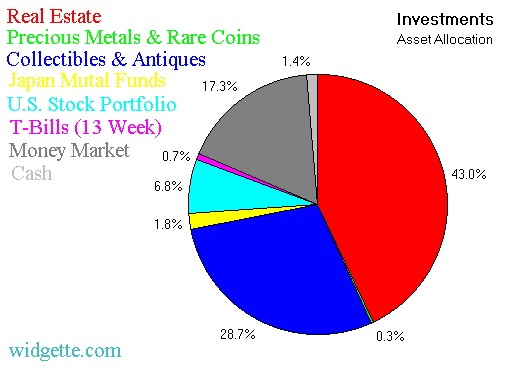Click here
to view the article,
Ironing Out The Ironies (The Economics of Your Liquid Assets).
Sure, you know
the best case scenario. But, what is the worse case scenario for your
money?
The accompanying chart shows how our investment pie is sliced up.
Our main investment vehicles, listed largest to smallest, are:
- Residential Real Estate (43%)
- Collectibles & Antiques (28.7%)
- Money Market (17.3%)
- Diversified U.S. Stock Portfolio (6.8%)
- Japan Mutual Funds (1.8%)
- Cash (1.4%)
- Treasury Bills [13 week] (0.7%)
- Precious Metals & Rare Coins (0.3%)
Within the U.S. stock market portfolio, these holdings
make-up 50% of the value:
RTRSY,
XON,
SBH,
AOL,
CMGI,
CSCO,
DJT,
GBLX,
LU,
ROV,
USW,
SUN,
WITC, and
SEEK.
Within the Japanese oriented mutual funds, the following should be noted:
- We usually frown on mutual funds. However, when you invest in
foreign countries, sometimes mutual funds make the most sense.
- We made certain these were no-load funds.
- We made sure there were no other costs or fees associated with
these mutual funds.
- The fund names include: Warburg Pincus Japan Growth,
Fidelity Japan, and
Fidelity Japan Small Companies. (Note: you must obey certain
rules to be exempt from loads and/or fees.)
The money market funds are spread-out over a few different accounts.
The interest rates being paid vary depending on the other services
that are available. For instance, the lowest interest rate is from the
bank that allows ATM transactions without a fee. The highest
interest rate comes from an Internet bank that offers no ATM
transactions.





